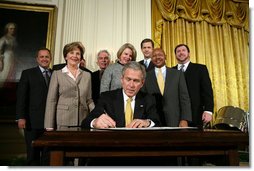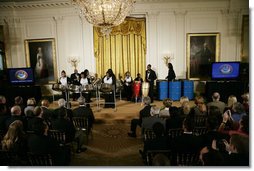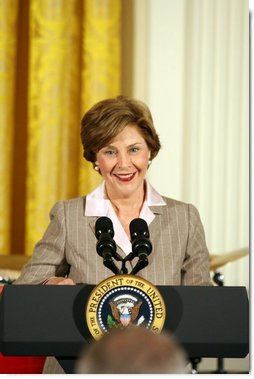
- Afghanistan
- Africa
- Budget Management
- Defense
- Economy
- Education
- Energy
- Environment
- Global Diplomacy
- Health Care
- Homeland Security
- Immigration
- International Trade
- Iraq
- Judicial Nominations
- Middle East
- National Security
- Veterans
|
Home >
News & Policies >
February 2008
|
For Immediate Release
Office of the Press Secretary
February 7, 2008
President and Mrs. Bush Discuss Helping America's Youth
East Room
![]() Fact Sheet: Continuing the Work of Helping Our Nation's Youth
Fact Sheet: Continuing the Work of Helping Our Nation's Youth
2:54 P.M. EST
THE PRESIDENT: Thank you all. Please be seated. Thank you for joining Laura and me. I've got two jobs; one is I'm going to sign an executive order here in a minute, making sure that all agencies involved with Helping America's Youth coordinate their activities. And then I've got to introduce Laura. (Laughter.)
I appreciate very much those of you who are committed to helping our country by saving souls, and by giving people hope. I think it's -- I can't think of a more noble cause than to serve America. And there's all kinds of ways to serve America. One way is to wear the uniform. Another way is to find somebody wonders whether or not there's a positive future in their lives, and put your arm around them and say, I love you; what can I do to help you?
That happens, by the way, all across America. And it doesn't take one single law to cause somebody to love a neighbor. It does take a law -- it's just -- it's a higher law. It's a law from a higher inspiration than government. And so today, Laura and I welcome those who are neighborhood healers and helpers. We really appreciate your focus on helping our nation's youth, particularly boys.
 In my State of the Union a couple years ago, I talked about the initiative
that we're honoring today, and it's an initiative that says there is a
better future for America's young folks. And we've set some important
goals, and one of the goals inside this administration is to make sure that
those people who are responsible for spending taxpayers' money on these
programs actually coordinate their efforts, and set high standards. A lot
of times in government we don't do a very good job of measuring, and so the
idea is to set standards and to coordinate, but the idea is also to empower
those who are on the front lines of saving lives.
In my State of the Union a couple years ago, I talked about the initiative
that we're honoring today, and it's an initiative that says there is a
better future for America's young folks. And we've set some important
goals, and one of the goals inside this administration is to make sure that
those people who are responsible for spending taxpayers' money on these
programs actually coordinate their efforts, and set high standards. A lot
of times in government we don't do a very good job of measuring, and so the
idea is to set standards and to coordinate, but the idea is also to empower
those who are on the front lines of saving lives.
I like to say, government is not really about love -- there may be loving people in government, but government itself is laws and justice; love is found in the hearts of our citizens who are in the neighborhoods.
And so the executive order I'm going to sign is to -- all aimed at leaving behind a structure so that whoever is lucky enough to follow me -- (laughter) -- will see a blueprint on how to help really people realize the great promise of the country.
I believe we solve -- save souls one person at a time. And I like to remind our fellow citizens, while one person can't save every soul, one person can save a soul. And it's that cumulative effort of love and compassion and work that will define a hopeful future. And somebody who shares that same passion about recognizing the true strength of America lies in the hearts and souls of our citizens, and someone who cares deeply about making sure the young in America have a bright future is our speaker, my wife, the First Lady, Laura Bush. (Applause.)
 MRS. BUSH: Thank you very much. Thank you, Mr. President, for that very
nice introduction. (Laughter.) Thank you, actually, for asking me to lead
Helping America's Youth. It's been such a wonderful and fulfilling three
years for me to have the chance to see all of the programs that I visited
all across our country and see the work that people are doing -- it's so
terrific -- in every neighborhood, just like you said. Thank you very
much.
MRS. BUSH: Thank you very much. Thank you, Mr. President, for that very
nice introduction. (Laughter.) Thank you, actually, for asking me to lead
Helping America's Youth. It's been such a wonderful and fulfilling three
years for me to have the chance to see all of the programs that I visited
all across our country and see the work that people are doing -- it's so
terrific -- in every neighborhood, just like you said. Thank you very
much.
Welcome, everyone, to the White House. Thanks to all of you who have worked so hard on Helping America's Youth. You are joined by adults across the United States who are sharing their time and wisdom and their love with our nation's young people. These adults are serving as role models and friends. And by becoming involved in the lives of children and teens, they're helping young people make the wise decisions that lead to healthy and successful lives.
We know that the challenges facing young people in the United States today are greater than in any earlier generation. Drugs and gangs, predators on the Internet, violence on television and in real life are just some of the negative influences that are present everywhere. Boys, especially, need the attention of adults. Today boys are less likely than girls to go to college, more likely to drop out of high school, and to be incarcerated.
As both boys and girls face these challenges, they often have fewer people to turn to for help. More children are raised in single-parent families, most often without a father. Millions of children have one or both of their parents in prison. Many children spend more time alone or with their peers than they do with any member of their family.
Right after that State of the Union address in 2005, we began to identify youth programs that could serve as models for communities all across our country. Since then, I've visited dozens of these programs. I've met with mentors and teachers, Big Brothers and Big Sisters. I've visited sports programs and fatherhood initiatives. I've seen programs that support military kids, Native American youth, and children on the Gulf Coast.
In Atlanta, I saw a debate program that shows middle-schoolers how to resolve conflicts, not with their fist, but with their minds and voices. In Los Angeles, I visited a program that offers gang members a new way to earn respect in their neighborhoods: through decent-paying jobs. If these terrific programs sound familiar, they should. After all, they're your programs.
 The White House Conference on Helping America's Youth, in October 2005,
brought together more than 500 parents, teachers, law enforcement,
researchers, government representatives and community leaders. Five
regional conferences have been held since in Indianapolis, Denver,
Nashville, St. Paul and Dallas, and the sixth regional conference will take
place in Portland, Oregon later this month.
The White House Conference on Helping America's Youth, in October 2005,
brought together more than 500 parents, teachers, law enforcement,
researchers, government representatives and community leaders. Five
regional conferences have been held since in Indianapolis, Denver,
Nashville, St. Paul and Dallas, and the sixth regional conference will take
place in Portland, Oregon later this month.
Many of your programs have been represented at these conferences, which have reached more than 30 states. More than 15,000 people have either attended a regional conference or watched one on the Helping America's Youth website. Helping America's Youth online has been a success, with more than 6 million hits since August 2006. And the Helping America's Youth News Flash, a new electronic newsletter, reaches thousands of readers every month.
At the regional conferences, nearly a thousand members of community partnerships have learned how to use the Community Guide to Helping America's Youth. The guide allows caring adults to use the Internet to learn more about the challenges facing children in their own communities. With the guide's interactive maps, adults can enter their own ZIP codes and find their local democratic -- demographic data and crimes statistics. Once they know the neighborhoods that have the most youth related problems, adults can use the Community Guide to find federally supported youth programs nearby.
The guide's program tool helps adults find youth initiatives that research has proven are effective in reducing substance abuse, gang activity and other challenges faced by our young people.
The Community Guide is a terrific online resource, and with this executive order the guide will evolve into a great new federal website. The new site will serve as a central information source that helps communities develop plans for serving their young people. None of this progress could have been possible without the collaboration of the federal agencies that support Helping America's Youth. This executive order will make sure that the Interagency Working Group can continue its successful efforts. And it will help increase the cooperation between federal, state and local governments, as well as the private sector.
Thanks to the officials who are here from these agencies for all of your hard work, and to the Cabinet members from these agencies that have joined us today. We wish you the very best as you take this working group on into its next phase.
The most important work of Helping America's Youth, though, isn't done here in Washington -- it's done in homes, schools and churches, out on playgrounds and in streets across our country. It's done by caring parents, teachers, clergy, coaches and mentors. It's done by adults who show young people they believe in them, which helps young people believe in themselves.
One of these caring adults is Dr. Gary Slutkin, founder of CeaseFire Chicago. To eradicate gang violence, CeaseFire mobilizes whole communities to address the conditions that lead to shootings. When I visited CeaseFire I heard how law enforcement, teachers, clergy and mentors helped kids get off the streets. Dr. Slutkin says that CeaseFire's outreach workers -- often former gang members, themselves -- are followed around like pied pipers, because these kids are so hungry for a good example. In the neighborhoods where CeaseFire works, shootings have dropped by as much as 80 percent.
Another one of these caring adults is Dr. Ken Canfield, who founded the National Center for Fathering. When I visited the center in Kansas City, I saw how it helps fathers develop emotional bonds with their children. When a father reads with his son or daughter, or just talks about his child's day, that child feels like the most important person in the world.
Sometimes showing fatherly affection doesn't take much time at all. One of my favorite parts of my visit to the center was watching the fathers and their children do the 15-second hug. Over time, 15-second hugs can give children a sense of security and love that never goes away.
Another caring adult is Daniel Varner, the CEO of Think Detroit. At Think Detroit, volunteers and the city's Police Athletic League help young people build character and develop healthy behavior through sports. When I visited Think Detroit in 2005, I was moved when one of the little boys I met responded to a reporter's question about my visit. The little boy simply said, I wish she could stay here.
Young people want us in their lives, and they need us in their lives. And as I've learned from the remarkable men and women I've met across our country, each of us has the power to help America's youth.
Many of these remarkable men and women are here today. Thank you all very much. Thank you to the Cabinet members, to the leaders of the youth programs, to our conference presenters, to members of the working group and the secretarial board, to the university presidents who've hosted our conferences, and to everyone who is working to improve the life of our young people. Along the way, you're improving our country, and President Bush and I are grateful to you for your work. (Applause.)
Now let's look back on three great years of Helping America's Youth.
(A video is shown.)
(The executive order is signed.)
END 3:10 P.M. EST


